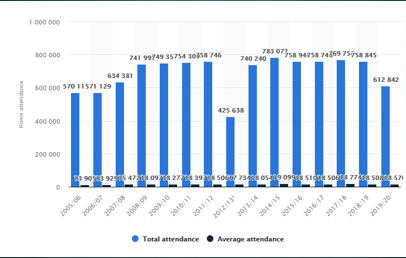Social Media Rise
As the 21st century has introduced new technological advancements, the world sees significant transformations. Social media is a relatively recent invention which only appeared in the current century. However, its rapid development allowed it to shift from away escapism to an important activity that attracts billions of people worldwide. As Hawi and Samaha (2017) say, one-third of the planet’s population is now registered in at least one social network. Facebook, Twitter, and Instagram quickly gain followers becoming major players in the mass media market, as the total number of their users grows by 10 percent annually. Therefore, it is possible to assume that the influence of social media has reached a significant level in a variety of spheres.
Sports Marketing
The purpose of this assignment is to investigate the impact of social media, or lack thereof, within the context of sports teams. As a matter of fact, sports marketing is a particular sphere that uses its own principles. While sports management and marketing activities demonstrate many similarities with other areas of business, such as production and event management, Vale and Fernandes (2017) discern a particular tendency that makes the difference. In the case of sports teams, their fans play the role of customers, but the nature of the relationship is different. Fans tend to build strong relations with their preferred team, and, according to da Silva and Las Casas (2017), sports marketing is particularly demanding in terms of effective communication.
The Impact of Social Media on Sports Marketing
Considering the tendencies described above, it is possible to say that social media has particularly strong potential in the context of sports marketing. Vale and Fernandes (2017) have conducted research concerning the relations of fans and their teams on the Internet. As the results show, there are seven motivations that make fans engage in the social media exchange. First of all, they search for relevant, fresh information and sports-related entertainment content from a team. At the same time, online interactions have valuable social aspects promoting integration and empowerment. Furthermore, people’s personal identity development becomes a key factor, along with the sense of remuneration. Simultaneously, fans’ love and dedication to their team is another incentive of active social media communication within the context of sports.
Overall, the motivations described previously serve as the incentives for people who use social media to interact with their favorite teams. All seven elements are equally important, and they promote three types of social network behavior. Consumption is the primary type, meaning that people are the recipients of content available online. In the case of sports teams’ social media accounts, “consumers” read new posts and watch videos without engaging in the process. At the same time, there is the contribution behavior when users are partially involved in the content in the form of commentaries or polls. Creators reach a new level of engagement, directly producing the content, thus reaching the highest point of online media involvement.
Washington Capitals Facebook
The present research examined the Facebook account of an NHL team called the Washington Capitals. Facebook is the world’s largest social network, uniting a broad array of users from the whole world. The format of Facebook allows for all the described motivations and behaviors to be present. As of October 29, 2020, the Facebook account of the Washington Capitals counted over 750-thousand followers, which is more than the official population of Washington D.C. While the statistics revealed the international presence among followers, the vast majority of them are from the United States and Canada. NHL venues are located in the aforementioned countries, making 80% of subscribers possible visitors of the Capitals’ games.
Washington Capitals Attendance since 2006
The presented slide demonstrates how the attendance rate of Washington Capitals’ home games has changed since 2006. The statistical data were collected by the Statista agency based on the official NHL information (Gough, 2020). The graph shows a significant increase in attendance in the late 2000s and early 2010s. From that point, the level has been steady, except for the latest season, which was negatively affected by the COVID-19 pandemic. The surge of attendance appears to correspond with the moment from which the popularity of social networks has been continuously increasing. As Facebook is the largest social network, it is possible to assume that it played a key role in the presented tendency. In other words, the development of social media increased the team’s exposure and attracted visitors, amounting to 17-percent growth.

References
Da Silva, E. C., & Las Casas, A. L. (2017). Sports marketing plan: An alternative framework for sports club. International Journal of Marketing Studies, 9(4), 15-28. Web.
Gough, C. (2020). Total/average regular season home attendance of the Washington Capitals from 2005/06 to 2019/20. Statista. Web.
Hawi, N. S., & Samaha, M. (2017). The relations among social media addiction, self-esteem, and life satisfaction in university students. Social Science Computer Review, 35(5), 576-586.
Vale, L., & Fernandes, T. (2017). Social media and sports: driving fan engagement with football clubs on Facebook. Journal of Strategic Marketing, 26(1).
Washington Capitals. (n.d.). Facebook. 2020, Web.